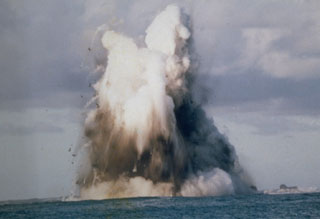Report on Nishinoshima (Japan) — 11 December-17 December 2019
Smithsonian Institution / US Geological Survey
Weekly Volcanic Activity Report, 11 December-17 December 2019
Managing Editor: Sally Sennert.
Please cite this report as:
Global Volcanism Program, 2019. Report on Nishinoshima (Japan) (Sennert, S, ed.). Weekly Volcanic Activity Report, 11 December-17 December 2019. Smithsonian Institution and US Geological Survey.
Nishinoshima
Japan
27.247°N, 140.874°E; summit elev. 100 m
All times are local (unless otherwise noted)
The Japan Coast Guard (JCG) reported that during an overflight of Nishinoshima on 15 December surveyors observed that explosions were occurring from the main crater of the pyroclastic cone every second to several seconds. Blocks were ejected as high as 300 m above the crater rim; red hot blocks were scattered at the base of the cone. Gray plumes rose from the crater, and lava continued flowing E into the sea. A new crater had opened on the N flank of the cone and effused lava that flowed NW down to the sea. JMA expanded the marine exclusion zone around the island to 2.5 km the next day.
Geological Summary. The small island of Nishinoshima was enlarged when several new islands coalesced during an eruption in 1973-74. Multiple eruptions that began in 2013 completely covered the previous exposed surface and continued to enlarge the island. The island is the summit of a massive submarine volcano that has prominent peaks to the S, W, and NE. The summit of the southern cone rises to within 214 m of the ocean surface 9 km SSE.
Sources: Japan Meteorological Agency (JMA), Japan Coast Guard

